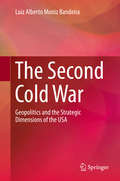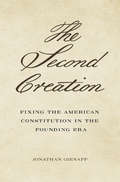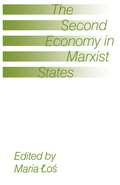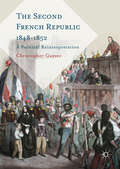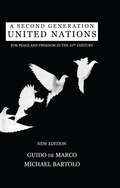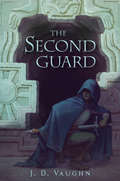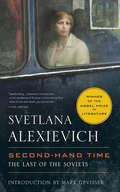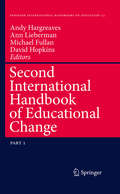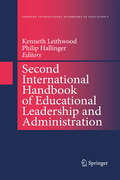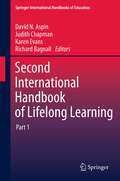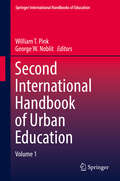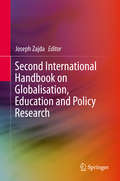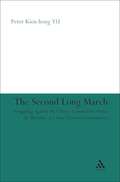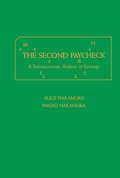- Table View
- List View
The Second Cold War: Geopolitics and the Strategic Dimensions of the USA
by Luiz Alberto Moniz BandeiraThis book investigates the geopolitics and strategic dimensions of US-American foreign policy during George W. Bush's and Barack Obama's presidential terms. Based on a vast amount of empirical and historical sources, the author offers deep insights into the recent political developments ('Arabellions') along the axis of Northern Africa, the Middle East, and Central Asia, situating them in the context of the global geopolitical and geo-economical Great Game, either latent or overt, between USA/NATO and Russia. The author also analyses the influence of the US on these historical and political processes in the last two decades.
The Second Creation: Fixing the American Constitution in the Founding Era
by Jonathan GienappAmericans widely believe that the U.S. Constitution was almost wholly created when it was drafted in 1787 and ratified in 1788. Jonathan Gienapp recovers the unknown story of the Constitution’s second creation in the decade after its adoption—a story with explosive implications for current debates over constitutional originalism and interpretation.
The Second Disestablishment: Church and State in Nineteenth-Century America
by Steven GreenDebates over the proper relationship between church and state in America tend to focus either on the founding period or the twentieth century. Left undiscussed is the long period between the ratification of the Constitution and the 1947 Supreme Court ruling in Everson v. Board of Education, which mandated that the Establishment Clause applied to state and local governments. Steven Green illuminates this neglected period, arguing that during the 19th century there was a "second disestablishment." By the early 1800s, formal political disestablishment was the rule at the national level, and almost universal among the states. Yet the United States remained a Christian nation, and Protestant beliefs and values dominated American culture and institutions. Evangelical Protestantism rose to cultural dominance through moral reform societies and behavioral laws that were undergirded by a maxim that Christianity formed part of the law. Simultaneously, law became secularized, religious pluralism increased, and the Protestant-oriented public education system was transformed. This latter impulse set the stage for the constitutional disestablishment of the twentieth century. The Second Disestablishment examines competing ideologies: of evangelical Protestants who sought to create a "Christian nation," and of those who advocated broader notions of separation of church and state. Green shows that the second disestablishment is the missing link between the Establishment Clause and the modern Supreme Court's church-state decisions.
The Second Disestablishment: Church and State in Nineteenth-Century America
by Steven GreenDebates over the proper relationship between church and state in America tend to focus either on the founding period or the twentieth century. Left undiscussed is the long period between the ratification of the Constitution and the 1947 Supreme Court ruling in Everson v. Board of Education, which mandated that the Establishment Clause applied to state and local governments. Steven Green illuminates this neglected period, arguing that during the 19th century there was a "second disestablishment." By the early 1800s, formal political disestablishment was the rule at the national level, and almost universal among the states. Yet the United States remained a Christian nation, and Protestant beliefs and values dominated American culture and institutions. Evangelical Protestantism rose to cultural dominance through moral reform societies and behavioral laws that were undergirded by a maxim that Christianity formed part of the law. Simultaneously, law became secularized, religious pluralism increased, and the Protestant-oriented public education system was transformed. This latter impulse set the stage for the constitutional disestablishment of the twentieth century. The Second Disestablishment examines competing ideologies: of evangelical Protestants who sought to create a "Christian nation," and of those who advocated broader notions of separation of church and state. Green shows that the second disestablishment is the missing link between the Establishment Clause and the modern Supreme Court's church-state decisions.
The Second Economy in Marxist States
by Maria LosThis book analyses and compares the unofficial economies and their control in ten marxist states: the USSR, Poland, Hungary, Romania, Yugoslavia, Cuba, Nicaragua, China, Angola and Tanzania. It provides a vivid, mosaic-like panorama of the hidden economies in these countries. The book breaks with the view that the unofficial economy is simply a by-product of the official economy. It shows an unfolding interplay between these two economies, which moulds and limits both the dynamics and the direction of the process of change. In her final essay, Maria Los develops a theoretical model linking second economies with the process of marxist economic development. The key stages of this process are identified as: (1) The stage of radical transformation; (2) The monopolisation period; (3) The reformist phase; and (4) Post- reformist decadence. The volume throws a new light on the prospects and problems of the reformist movements which have swept the Soviet Union, China and several other marxist states in the 1980s.
The Second French Republic 1848-1852: A Political Reinterpretation
by Christopher GuyverThis book follows the story of the Second French Republic from its idealistic beginnings in February 1848 to its formal replacement in December 1852 by the Second Empire. Based on original archival research, The Second French Republic gives a detailed account of the internal tensions that irrevocably weakened France’s shortest republic. During this short period French political life was buffeted by strong and often contrary forces: universal manhood suffrage, fear of socialism, the President Louis-Napoleon Bonaparte, and the political ambitions of the military high command for the restoration of the monarchy.
Second Generation United Nations
by Michael BartoloAs the United Nations moves beyond its fiftieth anniversary into the new millennium, it is faced with a new global system fraught with political and economic tensions that can no longer be handled with models that defined the organization when it was founded in 1945. An innovative vision for a restructuring of the United Nations, this book offers an insider's look at how the UN can respond more effectively to the challenges of the future in an age of globalization.
Second Generation United Nations
by Michael BartoloAs the United Nations moves beyond its fiftieth anniversary into the new millennium, it is faced with a new global system fraught with political and economic tensions that can no longer be handled with models that defined the organization when it was founded in 1945. An innovative vision for a restructuring of the United Nations, this book offers an insider's look at how the UN can respond more effectively to the challenges of the future in an age of globalization.
The Second Guard (A\second Guard Novel Ser. #1)
by J. D. VaughnIn the peaceful realm of Tequende, all second-born children must journey to the fantastical realm of Alcazar to fulfil the mandate of the Oath of Guilds as soon as they turn 15. There they train to earn a place among the queen's legendary second guard, or work as indentured servants. Talimendra has always wanted to join the guard, but there are dark rumours in the queendom that she may not be ready for. Rumours that whisper of greed, traitors and war.
Second-Hand Time: The Last of the Soviets
by Svetlana AlexievichIn Second-Hand Time, Alexievich chronicles the demise of communism. Everyday Russian citizens recount the past thirty years, showing us what life was like during the fall of the Soviet Union and what it’s like to live in the new Russia left in its wake. Through interviews spanning 1991 to 2012, Alexievich takes us behind the propaganda and contrived media accounts, giving us a panoramic portrait of contemporary Russia and Russians who still carry memories of oppression, terror, famine, massacres—but also of pride in their country, hope for the future, and a belief that everyone was working and fighting together to bring about a utopia. Here is an account of life in the aftermath of an idea so powerful it once dominated a third of the world. Alexievich’s distinctive documentary style, combining extended individual monologues with a collage of voices, records the stories of ordinary women and men who are rarely give the opportunity to speak, whose experiences are often lost in the official histories of the nation. Second-Hand Time will lead the South African reader to draw unexpected parallels with life after 1994.
Second Home Tourism in Europe: Lifestyle Issues and Policy Responses
by Zoran RocaBringing together a wide range of studies from twelve European countries, this book offers a state-of-the-art overview of the driving forces behind spatial diversity and social complexity inherent in second home expansion in all parts of the continent - from Scandinavia to the Mediterranean and from the British Isles to Russia - in the context of contemporary mobility patterns largely induced by tourism. As befits the overall conception of the book as a compendium of current second home research, planning and policy issues, the book endorses the following: multidisciplinary approaches to the second home phenomenon as an expression of the ’leisure class’ mobility and recreation-based lifestyles, as well as a constitutive element of post-productivist land-use patterns and landscape change; and socio-economic and territorial development planning and policy-related perspectives on social change and spatial re-organization provoked by the expansion of second home tourism in times of prosperity and crisis. ’This book shows that second home tourism has become such an important sector of the economy that it is no longer possible to let it develop freely: it is the source of new forms of social deprivation; it generates residential economies that are particularly sensitive to the economic cycle; it often impairs beautiful landscapes and increases human pressure on natural environments. As a result, it is one of the major physical planning stakes of touristic areas’ (From the concluding essay by Paul Claval, Université de Paris I - Sorbonne, Paris, France).
Second Home Tourism in Europe: Lifestyle Issues and Policy Responses
by Zoran RocaBringing together a wide range of studies from twelve European countries, this book offers a state-of-the-art overview of the driving forces behind spatial diversity and social complexity inherent in second home expansion in all parts of the continent - from Scandinavia to the Mediterranean and from the British Isles to Russia - in the context of contemporary mobility patterns largely induced by tourism. As befits the overall conception of the book as a compendium of current second home research, planning and policy issues, the book endorses the following: multidisciplinary approaches to the second home phenomenon as an expression of the ’leisure class’ mobility and recreation-based lifestyles, as well as a constitutive element of post-productivist land-use patterns and landscape change; and socio-economic and territorial development planning and policy-related perspectives on social change and spatial re-organization provoked by the expansion of second home tourism in times of prosperity and crisis. ’This book shows that second home tourism has become such an important sector of the economy that it is no longer possible to let it develop freely: it is the source of new forms of social deprivation; it generates residential economies that are particularly sensitive to the economic cycle; it often impairs beautiful landscapes and increases human pressure on natural environments. As a result, it is one of the major physical planning stakes of touristic areas’ (From the concluding essay by Paul Claval, Université de Paris I - Sorbonne, Paris, France).
Second Image IPE: Bridging the Gap Between Comparative and International Political Economy (International Political Economy Series)
by Andreas NölkeThis book argues that the lack of adequate theories of contemporary capitalism is due to the increasing separation of the sub-disciplines of Comparative and International Political Economy. Theorizing only takes place in one of the two over-specialized sub-disciplines of Political Economy, thereby leading to a neglect of the interplay between national and international dimensions of capitalism. The author seeks to rectify this gap by developing a theory of Second Image IPE. Based on the “second image” notion developed by Kenneth Waltz, he furthers the classical theoretical approaches as developed by Peter Gourevitch and Peter Katzenstein. For this purpose, he incorporates recent analytical developments in Comparative Capitalism and Growth Model analysis. The book demonstrates the usefulness of Second Image IPE theory by studying the major empirical topics of Global Political Economy, including security, finance, regional integration, trade, production and global order.
Second International Handbook of Educational Change (Springer International Handbooks of Education #23)
by David Hopkins Andy Hargreaves Michael Fullan Ann LiebermanThe two volumes of the second edition of the International Handbook of Educational Change comprise a totally new, and updated collection of the most critical and cutting-edge ideas in educational change. Written by the most influential thinkers in the field, these volumes cover educational change at both the theoretical and practical levels. The updated handbook remains connected to the classical concerns of the field, such as educational innovation, reform, and change management, and also offers new insights into educational change that have been brought about by social change and shifting contexts of educational reform. Like the first best selling Handbook, this one will also undoubtedly become an essential resource for people involved in all spheres of education, from classroom teachers, teacher leaders and administrators to educational researchers, curriculum developers, and university professors. No other work provides such a wide-ranging and comprehensive examination of the field of educational change.
Second International Handbook of Educational Leadership and Administration (Springer International Handbooks of Education #8)
by Kenneth A. Leithwood P. HallingerThe first International Handbook of Educational Leadership and Administration (Leithwood et al.) was published in 1996 and quickly became something of a best seller for reference works within education. Such success, we suggest, was at least partly due to the unprecedented global waves of concern for improving schools launched in the mid 1980's, combined with a widespread belief in leadership as the single most powerful contribution to such improvement. The roots of this belief can be found in evidence produced by the early "effective schools" research, although there is a "romance" with leadership! as an explanation for success in many non-school enterprises, as well. During the two-year period during which this current handbook was being written, activity in the realms of school leadership, school improvement, and leadership development gained further momentum. The English government created its new National College of School Leadership, and several Asian nations announced new initiatives in leadership selection, preparation, and development.
Second International Handbook of Lifelong Learning (Springer International Handbooks of Education #26)
by David N. Aspin, Judith Chapman, Karen Evans and Richard BagnallThe second edition of the International Handbook of Lifelong Learning is extensive, innovative, and international in scope, remit and vision, inviting its readers to engage in a critical re-appraisal of the theme of “lifelong learning”. It is a thorough-going, rigorous and scholarly work, with profound and wide-ranging implications for the future of educating institutions and agencies of all kinds in the conception, planning and delivery of lifelong learning initiatives. Lifelong learning requires a wholly new philosophy of learning, education and training, one that aims to facilitate a coherent set of links and pathways between work, school and education, and recognises the necessity for government to give incentives to industry and their employees so they can truly “invest” in lifelong learning. It is also a concept that is premised on the understanding of a learning society in which everyone, independent of race, creed or gender, is entitled to quality learning that is truly excellent.This book recognises the need for profound changes in education and for goals that are critically important to education, economic advancement, and social involvement. To those concerned about the future of our society, our economy and educational provision, this book provides a richly illuminating basis for powerful debate. Drawing extensively on policy analyses, conceptual thinking and examples of informed and world-standard practice in lifelong learning endeavours in the field, both editors and authors seek to focus readers' attention on the many issues and decisions that must be addressed if lifelong learning is to become a reality for us all.
Second International Handbook of Urban Education (Springer International Handbooks of Education)
by William T. Pink George W. NoblitThis second handbook offers all new content in which readers will find a thoughtful and measured interrogation of significant contemporary thinking and practice in urban education. Each chapter reflects contemporary cutting-edge issues in urban education as defined by their local context. One important theme that runs throughout this handbook is how urban is defined, and under what conditions the marginalized are served by the schools they attend. Schooling continues to hold a special place both as a means to achieve social mobility and as a mechanism for supporting the economy of nations. This second handbook focuses on factors such as social stratification, segmentation, segregation, racialization, urbanization, class formation and maintenance, and patriarchy. The central concern is to explore how equity plays out for those traditionally marginalized in urban schools in different locations around the globe. Researchers will find an analysis framework that will make the current practice and outcomes of urban education, and their alternatives, more transparent, and in turn this will lead to solutions that can help improve the life-options for students historically underserved by urban schools.
Second International Handbook on Globalisation, Education and Policy Research
by Joseph ZajdaThis handbook presents a global overview of developments in education and policy change during the last decade. It provides an accessible, practical and comparative source of current research that examines the intersecting and diverse discourses of this important issue.Divided into two parts, the handbook first examines globalisation and education policy reforms, including coverage of main trends as well as specific policy issues such as gender, equity, minorities and human rights. Next, the handbook offers a comparative perspective that evaluates the ambivalent and problematic relationship between globalisation, the state and education reforms globally. It features coverage on curricula issues and education reforms in schools around the world as well as the curriculum in the global culture.Now more than ever there is a need to understand and analyse both the intended and the unintended effects of globalisation on economic competitiveness, educational systems, the state and relevant policy changes--all as they affect individuals, the higher education sector, schools, policy-makers and powerful corporate organisations across the globe. By examining some of the major education policy issues, particularly in the light of recent shifts in education and policy research, this handbook offers readers a comprehensive picture of the impact of globalisation on education policy and reforms. It will serve as a vital sourcebook of ideas for researchers, practitioners and policy makers in education.
The Second Long March: Struggling Against the Chinese Communists Under the Republic of China (Taiwan) Constitution
by Peter Kien-Hong YUThis work, written by an expert in the politics of Mainland China and Taiwan, looks at the role the Constitution of the Republic of China has played in the development of Taiwan since 1949 and its potential influence on the People's Republic of China.The Chinese Communists conducted the first long march for the sake of the majority of Chinese people, with the victory of MAO Zedong. In the second long march, CHIANG Kai-shek and his successors tried to convert the Chinese mainland from a Communist, totalitarian system, into a democratic, prosperous one by relying on the spirit of the Republic of China (ROC) constitution and by setting itself as a good example, in gradually guaranteeing freedom and democracy. Needless to say, this march is long and difficult. The Second Long March challenges other models and theories on the study of the relationship between the ROC (Taiwan area) and mainland China or the People's Republic of China (PRC) since China became politically (as opposed to legally) divided in December 1949. Arguably, it is the ROC Constitution that has helped ROC citizens to live in a non-Communist or anti-Communist political system. Actively promoting democracy and freedom on the Chinese mainland (neidi) can further guarantee the Taiwan area's survival. The book will provide valuable scholarship of interest to anyone researching the political history of China and its prospects for democratization.
Second Nature Urban Agriculture: Designing Productive Cities
by André Viljoen Katrin BohnWinner of the 2015 RIBA President's Award for Outstanding University Located Research This book is the long awaited sequel to "Continuous Productive Urban Landscapes: Designing Urban Agriculture for Sustainable Cities". "Second Nature Urban Agriculture" updates and extends the authors' concept for introducing productive urban landscapes, including urban agriculture, into cities as essential elements of sustainable urban infrastructure. It reviews recent research and projects on the subject and presents concrete actions aimed at making urban agriculture happen. As pioneering thinkers in this area, the authors bring a unique overview to contemporary developments and have the experience to judge opportunities and challenges facing those who wish to create more equitable, resilient, desirable and beautiful cities.
Second Nature Urban Agriculture: Designing Productive Cities
by André Viljoen Katrin BohnWinner of the 2015 RIBA President's Award for Outstanding University Located Research This book is the long awaited sequel to "Continuous Productive Urban Landscapes: Designing Urban Agriculture for Sustainable Cities". "Second Nature Urban Agriculture" updates and extends the authors' concept for introducing productive urban landscapes, including urban agriculture, into cities as essential elements of sustainable urban infrastructure. It reviews recent research and projects on the subject and presents concrete actions aimed at making urban agriculture happen. As pioneering thinkers in this area, the authors bring a unique overview to contemporary developments and have the experience to judge opportunities and challenges facing those who wish to create more equitable, resilient, desirable and beautiful cities.
The Second Palestinian Intifada: A Chronicle of a People's Struggle
by Ramzy BaroudThis is a comprehensive account of the momentous events which shaped the political landscape not only of Palestine and Israel but of the entire Middle East region. *BR**BR*Addressing the most controversial issues, including the alarming escalation in suicide bombings, and the construction of the Separation Wall, he reports on the huge rate of unemployment and hunger in the Occupied Territories - statistics so critical that NGOs compare their magnitude to African nations such as the Congo. From the brutality of the Israeli army to the ever-compromising nature of the Palestinian Authority, few are spared Ramzy Baroud’s thoughtful critique.*BR**BR*The book is clear and concise, with one chapter dedicated to the major events of each year, and includes a comprehensive timeline.
The Second Partition of Palestine: Hamas–Fatah Struggle for Power
by Subhash SinghThis book examines the factors and issues responsible for the intra-Palestinian conflict that has undermined the strength and vitality of the struggle for liberation against the state of Israel. It explores how the ideological incompatibility and competition for political primacy account for the Hamas–Fatah conflict, entailing the risk of partition of Palestine even before it takes shape as an independent, sovereign entity. It analyzes the developments since the signing of the September 1993 Oslo Accord and discusses themes such as the background of Palestinian politics; the role of Fatah; the rise of Hamas as Fatah’s political rival; the Hamas–Fatah struggle for power; and the role played by the international community, including by the US and the European Union. The study deals with the various facets of territorial and political challenges faced by the rival Palestinian actions; the failure of the reconciliation efforts by Egypt and Yemen; the stalled peace process in the West Bank and Gaza Strip; the emergence of the Islamic resistance movement and secular nationalist party; and the political and ideological shifts in Palestinian politics. Comprehensive and topical, this book will be useful to scholars and researchers of West Asian studies, peace and conflict studies, politics and international relations, foreign policy, political studies, area studies and strategic and defence studies.
The Second Partition of Palestine: Hamas–Fatah Struggle for Power
by Subhash SinghThis book examines the factors and issues responsible for the intra-Palestinian conflict that has undermined the strength and vitality of the struggle for liberation against the state of Israel. It explores how the ideological incompatibility and competition for political primacy account for the Hamas–Fatah conflict, entailing the risk of partition of Palestine even before it takes shape as an independent, sovereign entity. It analyzes the developments since the signing of the September 1993 Oslo Accord and discusses themes such as the background of Palestinian politics; the role of Fatah; the rise of Hamas as Fatah’s political rival; the Hamas–Fatah struggle for power; and the role played by the international community, including by the US and the European Union. The study deals with the various facets of territorial and political challenges faced by the rival Palestinian actions; the failure of the reconciliation efforts by Egypt and Yemen; the stalled peace process in the West Bank and Gaza Strip; the emergence of the Islamic resistance movement and secular nationalist party; and the political and ideological shifts in Palestinian politics. Comprehensive and topical, this book will be useful to scholars and researchers of West Asian studies, peace and conflict studies, politics and international relations, foreign policy, political studies, area studies and strategic and defence studies.
The Second Paycheck: A Socioeconomic Analysis of Earnings
by Alice Nakamura Masao NakamuraThe Second Paycheck: A Socioeconomic Analysis of Earnings is a comprehensive analysis of the socioeconomic aspects of earnings, with emphasis on the dynamic labor supply behavior of men and women. The importance of dynamic models in understanding labor supply is highlighted. The impact of children on the dynamic labor supply of men and women, and how changes in marital status affect female labor supply, are also discussed. Comprised of eight chapters, this book begins by considering several reasons why the labor force behavior of married women has become an important topic in the mainstream of the economics literature. The work behavior of married women is examined in the larger context of the work behavior of married and unmarried men and women. Furthermore, a microanalytic simulation approach to behavioral research and forecasting is presented. The behavioral model used in this study is then described. In addition to coefficient estimates, the probabilities of work, expected wage rates and expected hours of work are analyzed. A Heckman-type model of work behavior is also generalized to include unemployment.This monograph is intended for economists, sociologists, students of labor economics, researchers, forecasters, and those from all backgrounds who are interested in understanding or forecasting the employment and earnings behavior of women.
